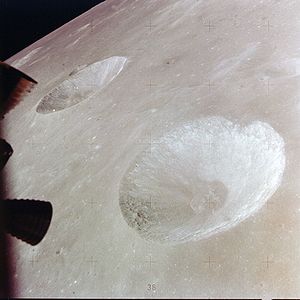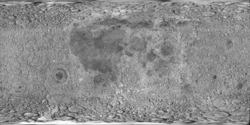Hill (kráter)
| Kráter Hill | |
|---|---|
 | |
| Souřadnice na Měsíci | |
| Selenografická šířka | 20,9° S |
| Selenografická délka | 40,8° V |
| Další údaje | |
| Průměr kráteru | 16 km [1] |
| Hloubka | 3,3 km |
| Colongitudo | 320° |
| Eponym | George William Hill |


Hill je impaktní kráter nacházející se u východního okraje Sinus Amoris (Záliv lásky) na přivrácené straně Měsíce. Má průměr 16 km, pojmenován je podle amerického astronoma a matematika George Williama Hilla.[1][2] Je kruhovitého tvaru se svažujícími se stěnami a malou plochou dna kolem středu. Než jej Mezinárodní astronomická unie v roce 1973 přejmenovala, nesl název Macrobius B.[1]
Jihojihozápadně leží kráter Carmichael a severovýchodně lávou zatopený kráter s nepravidelným tvarem Esclangon.[1]
Odkazy
Reference
Literatura
- RÜKL, Antonín. Atlas Měsíce. 2. vyd. Praha: Aventinum, 2012. ISBN 978-80-7151-269-1.
Externí odkazy
 Obrázky, zvuky či videa k tématu Hill na Wikimedia Commons
Obrázky, zvuky či videa k tématu Hill na Wikimedia Commons - Kráter Hill Archivováno 30. 5. 2018 na Wayback Machine., Moon-Wikispaces.com (anglicky)
- LAC 43, mapa 1:1 000 000 (Lambertova projekce)
Média použitá na této stránce
cylindrical map projection of the Moon. The Moon's whole surface was mapped by the Clementine spacecraft in 1994, here North is at the top. The dark floor of crater Plato is at the middle top above Mare Imbrium, while the bright floor and rays of crater Tycho is near the middle bottom below Mare Imbrium. Mare Procellarum is at the near left, and Mare Tranquillitatis is just right of centre and Mare Crisium is at the near right. The far left and far right show the contrast of the mostly cratered farside with small isolated mare.
Hill lunar crater as seen from Earth with satellite craters labeled
Sinus Amoris and Lacus Bonitatis with craters Roemer, Macrobius, Maraldi and others (detail of LROC - WAC global moon mosaic)




